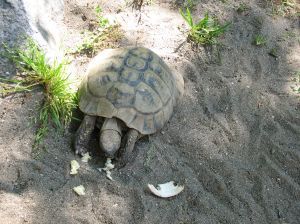Pet turtles are often labeled easy to care for, low maintenance pets. This isn’t entirely true. Pet turtles require specialized care and feeding and can get sick and die easily unless you know exactly what they need. Here are a few tips for taking care of pet turtles that can help you have turtle success.
First of all, research your turtles. If you are looking for a pet turtle, do some research into what type of turtle to get and what they need to stay healthy. Different species of turtles require different care. Some like it humid while others don’t. Some are mostly aquatic where others are land lovers. A good land turtle to start out with is a box turtle. There are several types of box turtles, you will need to choose your box turtle type based on the climate where you live and the enclosure you are willing and able to provide.
Try to get captive bred pet turtles. Wild caught turtles present a problem for the environment as well as turtle populations. Most pet stores that carry pet turtles get them from the wild and this is a big problem. Wild caught turtles get stressed easily and sometimes die within days or weeks of taking them home. They have a very hard time acclimating to captivity and they will always try to get free. Wild caught turtles tend to carry parasites which can infect any current turtle pets you may have and can cause them a lot of problems if you don’t get them qualified vet care. Taking massive amounts of wild turtles out of nature impacts the environment in negative ways. These little guys are beneficial to our environment and without them things get out of balance which can cause different species of pests to flourish and spread.
Captive bred turtles are a little harder to find than just going down to the local pet store. Most pet stores will tell you their turtles are captive bred just to make a sale but beware, very few are. The best place to find actual captive bred turtles of all types is online. Most turtle farms and private breeders have websites that list their contact info as well as what they have for sale. Captive bred turtles usually require a health certification by the breeder in order to be sold legally, make sure your breeder can provide all documents needed to ensure you purchase a healthy animal. Turtles under four inches in shell length are illegal to sell in the US. Make sure the turtle you purchase is of proper size to be sold. Captive bred turtles make excellent pets, they take easily to humans and don’t get stressed nearly as much as their wild counterparts.
Make sure you feed them what they need. Most land turtles are opportunistic omnivorous. This means that they eat a little bit of whatever they can find. Wild caught turtles tend to be more carnivorous, as do certain types of captive bred turtles. Your turtle will need an overall balanced diet, meaning the daily diet doesn’t have to be perfectly balanced but overall your turtle should be getting a variety of foods, both animal and plant based. Never feed your turtle the same exact foods two feedings in a row. Vary the diet so they don’t develop unhealthy food addictions. This is especially true for “wiggly” foods. Things such as live worms and crickets, if fed too often, can make your turtle picky and may cause them to stop eating other foods.
One food from each group of foods in every feeding can help achieve an overall balance of diet with protein making up approximately 40% to 50% of the diet or you can alternate groups of foods. The groups are: proteins such as worms, crickets, etc; fruits such as grapes, berries and melons; greens such as mustard greens and dandelion greens; and vegetables such as grated squash and green beans.
Make sure your pet turtle is getting enough vitamins in it’s diet. A good reptile multivitamin supplement is recommended for adding to feedings. Just sprinkle a little over the top of your turtles food so they get a little with each bite. Don’t over do it, follow the directions on the container. Fresh foods we buy at the supermarkets often don’t contain the quantities of vitamins and minerals our captive turtles need to survive so a good multi-supplement can help keep your pet healthy for a long time. Don’t overdo the vitamins, too much can be as devastating as not enough. One way to make sure your turtle is getting enough calcium is to shave a little bit of cuttle bone over their food. Cuttle bones can be purchased in the bird section of the pet area for about a dollar or so. You can also put a cuttle bone in your turtles enclosure so they can pick at it whenever they feel the need for more calcium in their diet.
Your turtle needs natural light, or at least replicated natural light. If you are using an outdoor enclosure this shouldn’t be a problem just make sure the pen faces East so it can get the morning sun. If using an indoor enclosure, your turtle will need light. Typically you will need two light sources, one incandescent light for warmth and a good UV florescent light for nutrition. Turtles need UV light to process vitamin D3 and produce the calcium it needs for bone and shell health. Metabolic bone disease is common among pet turtles and can be avoided with a good diet and a good UV light. You can’t buy a good UV bulb at most stores, the full spectrum daylight bulbs don’t provide the UV your turtle needs. Even stores that deal in florescent bulbs most of the time won’t be able to provide what you need. Go to a reputable pet store or go online and look for UV bulbs such as the Repti-Sun line of bulbs. These bulbs can be costly and need to be replaced every six months even if they don’t burn out, due to the way the UV output decreases over time, and are vital to the health and well being of your indoor turtle.
You need to be able to provide adequate space for your pet turtle. If you think a ten gallon aquarium is going to do it, you’d be wrong. Most turtles will quickly outgrow a small enclosure. Even smaller species of pet turtles need quite a bit of room to roam and house their amenities. Your indoor pet turtle needs a warm end and a cooler end of their enclosure, the incandescent light on one end can provide this. On the warm end, they need a basking rock to lay out on and get warm. Somewhere in the enclosure they need a water dish big enough for them to climb into and a way to climb out. This can be achieved by burying a water bowl in the substrate to ground level and placing a rock in one end so they can climb on it to get out easily. They also need a hide box of some kind, this will help them stay de-stressed. A cardboard box with a hole cut in it, a piece of driftwood, or a commercially sold hide box will work just fine. They will also need a feeding rock for daily feedings. This can be a flat rock or a commercially produced paving stone or whatever you choose. Feeding on a stone surface instead of a paper plate or bowl will help keep the turtles claws and beak in good shape so they won’t over grow.
Use good substrate, newspapers are easy to clean up but don’t give your turtle any chance to dig. Turtles love to burrow and dig, especially when it is getting close to hibernation time. Mixing some sand with a good topsoil can be a great substrate for your turtle. Make sure it is pesticide and fertilizer free, these things can hurt your new pet. There are also commercially available bark substrates sold in pet stores that are very good. A mister set on a timer, or a bottle mist every few hours is great. This will make your turtle feel good, maintain humidity levels, and keep the substrate soft for digging.
Make sure the walls of your enclosure are high enough to keep your turtle from climbing out, turtles are excellent escape artists. Also make sure your enclosure is protected from other animals, especially outdoor pens. Some predators can kill a turtle in minutes if given the chance.
Turtles need regular annual hibernation times to stay healthy. Depending on your climate and what type of turtle you have will determine when they should hibernate but a good general rule is about 3 to 5 months over the colder parts of the winter. Do not hibernate a young, underweight, or sick turtle, this can kill them during the hibernation. If your turtle isn’t perfectly healthy and of a good weight, keep them out of hibernation during the winter. Not hibernating a young, sick, or underweight turtle is much healthier than risking it.
If your turtle is a healthy adult that has been eating good all summer, start to “winterize” it a few weeks before hibernation time. Stop feeding protein foods and go strictly to leafy greens and a few veggies for a week or so to help the turtle get all of the protein out of it’s gut. Then stop feeding totally for a couple weeks while you gradually lower the temperature of the enclosure in 5 degree increments. This will help get the rest of the food out of the gut so it doesn’t rot over the winter and also starts slowing your turtles metabolism down to get ready for hibernation. When your turtle gets sluggish and starts sleeping more, put it in your hibernation box or area and monitor it weekly over the winter. If it wakes up it may need a drink so keep an eye on it.
If you have an outside enclosure make sure you have an area dug down deep that has soft dirt in the hole so your turtle can get down into it. Make sure it won’t flood, and make sure it is below the freeze line. Fill the hole with the loose dirt and cover that with a pile of leaves. This will be nice for your turtle to dig in as well as provide some warmth and insulation to the turtle in the hole under it. Check on it weekly, make sure no animals are trying to dig up your pet turtle for an easy sleeping snack.
This is by no means everything to know about taking care of pet turtles but I hope it has given you a good place to start and a basic understanding of pet turtle care. Be mindful of what your pet turtle needs and it should live a long and healthy life.



